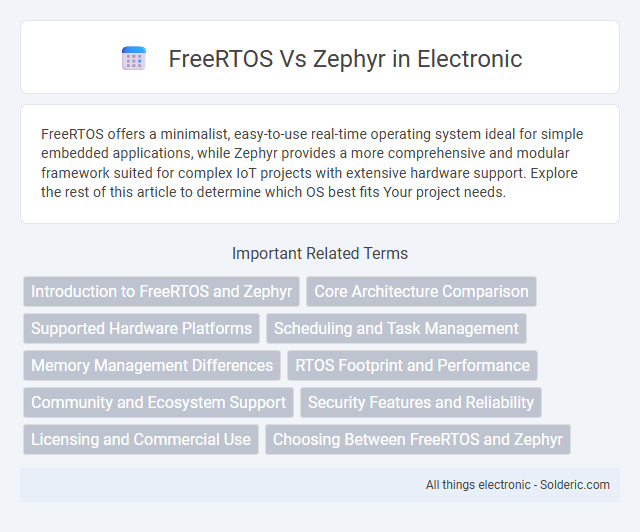FreeRTOS offers a minimalist, easy-to-use real-time operating system ideal for simple embedded applications, while Zephyr provides a more comprehensive and modular framework suited for complex IoT projects with extensive hardware support. Explore the rest of this article to determine which OS best fits Your project needs.
Comparison Table
| Feature | FreeRTOS | Zephyr |
|---|---|---|
| License | MIT License | Apache 2.0 License |
| Kernel Type | Real-Time Operating System (RTOS) | Real-Time Operating System (RTOS) |
| Supported Architectures | ARM, RISC-V, MSP430, AVR, x86, others | ARM, RISC-V, x86, ARC, NIOS II, Tensilica, others |
| Memory Footprint | Minimal (as low as 6 KB) | Moderate (typically 20-50 KB) |
| Connectivity | Basic TCP/IP stack via third-party libraries | Built-in Bluetooth, Wi-Fi, Ethernet stacks |
| File System Support | Limited, requires external integration | Included native file system support |
| Development Ecosystem | Broad community and commercial support, extensive documentation | Growing community, rich SDK integrations |
| Security Features | Basic; depends on user implementation | Advanced security modules, including secure boot and cryptography |
| Use Cases | Simple embedded applications, IoT devices, microcontrollers | Complex IoT, wearable tech, connected devices, industrial applications |
| Release Model | Stable long-term support releases | Frequent releases, active feature updates |
Introduction to FreeRTOS and Zephyr
FreeRTOS is an open-source real-time operating system designed for microcontrollers and small embedded systems, emphasizing simplicity and minimal resource usage with a rich set of APIs for task management and inter-task communication. Zephyr is a scalable, modular open-source RTOS developed by the Linux Foundation, targeting a wide range of hardware platforms with extensive connectivity, security features, and support for modern IoT applications. Both FreeRTOS and Zephyr support real-time scheduling, but Zephyr offers broader hardware abstraction and integrated middleware suited for complex, connected devices.
Core Architecture Comparison
FreeRTOS features a minimalist, single-kernel architecture optimized for real-time performance and ease of porting on various microcontrollers. Zephyr employs a modular, microkernel-based architecture designed for scalability, supporting multiple subsystems and device drivers within a unified framework. Your choice depends on whether you prioritize simplicity and resource efficiency (FreeRTOS) or extensibility and feature richness (Zephyr).
Supported Hardware Platforms
FreeRTOS supports a wide range of microcontrollers from vendors like ARM Cortex-M, ESP32, and RISC-V, making it ideal for diverse embedded applications. Zephyr offers extensive hardware compatibility, including ARM Cortex-M, x86, ARC, and RISC-V architectures, alongside support for popular SoCs from Intel, NXP, and Nordic Semiconductor. Your choice should consider the specific hardware platform to ensure optimal performance and integration with each RTOS's ecosystem.
Scheduling and Task Management
FreeRTOS uses a preemptive priority-based scheduler with optional round-robin scheduling for tasks of equal priority, allowing efficient real-time performance suited for embedded applications requiring deterministic task management. Zephyr supports both preemptive and cooperative multithreading with configurable scheduling policies, including priority-based round-robin and FIFO, enabling flexible task management in complex IoT environments. Both RTOSes provide robust APIs for task creation, synchronization, and inter-task communication, but Zephyr's modular design offers more extensive support for different scheduling strategies and advanced features like work queues.
Memory Management Differences
FreeRTOS employs a simple and deterministic memory management system with static and dynamic allocation options, prioritizing minimal footprint and real-time performance. Zephyr offers a more flexible memory management model with support for multiple allocators, including slab, heap, and memory pools, allowing for efficient memory handling in complex applications. Your choice between FreeRTOS and Zephyr should consider these differences to ensure optimal resource utilization and system stability.
RTOS Footprint and Performance
FreeRTOS features a minimal footprint, typically around 5-10 KB of flash memory, making it ideal for resource-constrained embedded systems with predictable real-time performance. Zephyr, while slightly larger at approximately 15-20 KB, offers enhanced scalability and supports more complex features, leading to increased flexibility but a higher memory footprint. You should consider FreeRTOS for ultra-low footprint requirements and Zephyr when advanced performance and extended feature sets are necessary.
Community and Ecosystem Support
FreeRTOS offers a vast community with extensive AWS support, numerous third-party libraries, and widespread industry adoption, making it ideal for projects requiring stability and long-term maintenance. Zephyr features a rapidly growing open-source community driven by the Linux Foundation, with strong contributions from leading tech companies and diverse hardware support, fostering innovation and collaboration. Both ecosystems provide robust forums, detailed documentation, and integration tools, but FreeRTOS emphasizes commercial backing while Zephyr excels in open governance and community-driven enhancements.
Security Features and Reliability
FreeRTOS offers robust security through features like memory protection units (MPU), secure kernel mechanisms, and support for Trusted Firmware-M, enhancing real-time application reliability. Zephyr includes comprehensive security capabilities such as kernel object access control, cryptographic libraries, and secure boot, designed to protect IoT devices from evolving threats effectively. Both platforms deliver reliability with deterministic scheduling and fault tolerance, but your choice should consider specific security protocols and device constraints tailored to your project needs.
Licensing and Commercial Use
FreeRTOS operates under the MIT License, allowing flexible commercial use without stringent copyleft requirements, making it highly suitable for proprietary projects. Zephyr uses the Apache 2.0 License, which permits commercial applications but includes explicit patent grant clauses to protect users against intellectual property claims. Your choice depends on balancing minimal licensing restrictions with your organization's legal and commercial priorities.
Choosing Between FreeRTOS and Zephyr
When choosing between FreeRTOS and Zephyr, consider your project's complexity and hardware requirements, as FreeRTOS excels in lightweight and real-time applications while Zephyr offers extensive middleware and multi-threading support suitable for more complex IoT devices. FreeRTOS provides a minimalistic kernel with broad industry adoption and simplicity, whereas Zephyr features a modular architecture with built-in device drivers and networking stacks, enhancing scalability and connectivity. Your decision should balance resource constraints, development ecosystem, and community support to ensure seamless integration and future-proofing.
FreeRTOS vs Zephyr Infographic

 solderic.com
solderic.com